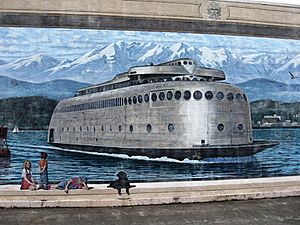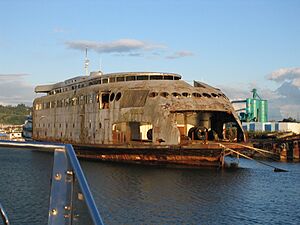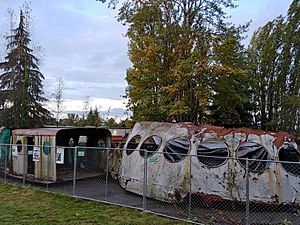MV Kalakala facts for kids
class="infobox " style="float: right; clear: right; width: 315px; border-spacing: 2px; text-align: left; font-size: 90%;"
| colspan="2" style="text-align: center; font-size: 90%; line-height: 1.5em;" | 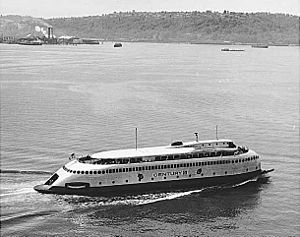
|}
The Motor Vessel Kalakala was a famous ferry boat that sailed on Puget Sound in Washington State. It operated from 1935 until it was retired in 1967.
The MV Kalakala was special because of its unique streamlined design. It had a very modern and fancy look, with luxurious features inside. People loved this boat! It was so popular that visitors to Seattle during the 1962 Seattle World's Fair voted it the second most popular attraction, right after the Space Needle. The Kalakala is known as the world's first truly streamlined ship because of its cool art deco style.
After it stopped carrying passengers in 1967, the ship was moved to Kodiak, Alaska. There, it was used as a factory for processing shrimp. In 1998, the Kalakala was brought back to Puget Sound. Its owner hoped to fix it up and make it new again. However, the ship kept getting worse. By 2011, the Coast Guard said it was a danger because it was falling apart. Sadly, enough money couldn't be found to restore it, so the Kalakala was taken apart for scrap metal in 2015.
Contents
| History | |
|---|---|
| Name | Peralta |
| Owner | Key System |
| Launched | 1926 |
| In service | 1926 |
| Out of service | 1933 |
| Status | Severely damaged by fire, later restored |
| Name | Kalakala |
| Owner | Puget Sound Navigation Company |
| Launched | 1935 |
| In service | 1935 |
| Out of service | 1967 |
| Fate | Lack of funding; scrapped |
| Status | Scrapped in February, 2015 |
| General characteristics | |
| Displacement | 1,475 tons (light) |
| Length | 276 ft (84 m) |
| Beam | 55 ft 8 in (16.97 m) |
| Depth | 21 ft 6 in (6.55 m) |
| Installed power | Busch-Sulzer direct drive diesel engine 3,000 hp (2,200 kW) |
| Propulsion | 10 cylinder engine, single screw |
| Speed | 17.5 knots (32.4 km/h; 20.1 mph) (max) |
|
MV Kalakala (ferry)
|
|
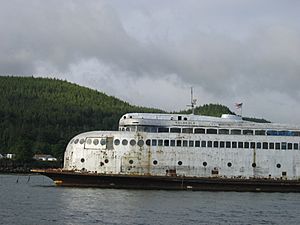
Port side view of Kalakala as seen in Neah Bay in 2004
|
|
| Built | 1926 |
| NRHP reference No. | 06000177 |
| Added to NRHP | 22 March 2006 |
The Ship's Early Life
Peralta: A Ferry's Beginning
Before it was the Kalakala, this ship was called the Peralta. It was built for the Key System ferry service in San Francisco Bay. The Peralta carried people and cars between Oakland and San Francisco. It was named after an important Spanish family who helped found the area.
The Peralta was launched in April 1926. It was designed to go in both directions without turning around, and it used a steam-powered electric engine.
In February 1928, while the Peralta was docking in Oakland, its front end dipped into the water. This caused waves to wash over the deck. An accident occurred, causing damage to the ship and injuries to some passengers. Investigators found that the accident happened because the ship's ballast tanks (which help balance the boat) were not filled correctly.
Later, in May 1933, a fire started on land near where the Peralta was docked in Oakland. The fire spread to the ship, and its upper parts were badly damaged. The insurance company decided the ship was too damaged to be repaired.
Rebuilding into the Kalakala
Even though the Peralta was badly burned, its main body (hull) was still in good shape. Alexander Peabody, who was the president of the Puget Sound Navigation Company (also known as the "Black Ball Line"), saw a chance to save it. On October 12, 1933, his company bought the ship. The hull was then towed to Lake Washington Shipyards in Houghton, Washington to be rebuilt as a new ferry.
For the next two years, the ship was completely transformed. All the damaged parts and old machinery were removed. The ship was also made a bit narrower.
Only one diesel engine was put in the new ship. It was planned to operate as a "single-ender," meaning it would dock with its front at Bremerton and its back at Seattle. This route was long, so speed was important. The ship also needed to carry both people and cars.
Mr. Peabody's wife suggested that the new ship should look unique and modern. So, he decided to give it a sleek, streamlined design. An engineer from Boeing, Louis Proctor, helped with the early ideas. The ship's bridge (where the captain steers) was set back, like a plane's cockpit. It even had a "flying bridge" that looked like wings, fitting the airplane theme. Inside, the ship had a modern art-deco style. It featured a restaurant, a lounge for ladies, and a bar for men. There were even showers for shipyard workers traveling home from Bremerton.
A new building method called arc-welding was used instead of rivets. This made the ship's surface look smooth and seamless, which fit the streamlined design. The Kalakala was the first ship to use this new welding technique. The new bridge and wheelhouse were built entirely from copper. This was done because people worried that steel might interfere with the ship's compass.
In November 1934, William O. Thorniley, who worked for the ferry company, named the new ferry Kalakala. This name was said to mean "bird" in Chinook Jargon, a Native American trade language from the Pacific Northwest. Thorniley started a big advertising campaign with billboards that just said "KALAKALA!" Later, they added "KALAKALA, Seattle, WA" and a picture of the ship.
This name started a tradition. All the ferry boats owned by the Washington State Department of Transportation (which took over the Kalakala in 1951) now have names from Native American languages.
Life as a Ferry
Kalakala's Service Years
After some big celebrations, the Kalakala began its service on July 4, 1935. It quickly became a famous symbol of the area. Besides its regular ferry trips, it was also used for fun "moonlight cruises" with live dance music.
During World War II, the Kalakala was very busy. It transported shipyard workers and Navy personnel between Seattle and Bremerton, often on a longer schedule. Because of this hard work, it earned the nickname "The Workhorse of Puget Sound."
However, the Kalakala's airplane-inspired design had some problems. The bridge was set back too far, making it hard for the captain to see the front of the ship when docking. The small, round windows also made it difficult to see all around. The car deck was made narrower for looks, which meant it couldn't carry as many vehicles. As American cars got wider after the war, the ship could carry 40% fewer cars. This made it less efficient and harder for passengers to walk between cars. When newer, more efficient ferries like the Evergreen State class boats arrived in the mid-1950s, the Kalakala became outdated. Still, its enclosed front made it good for routes with open water, like the one between Port Angeles and Victoria, where it sailed from 1955 to 1959.
The Kalakala also had a strong shaking vibration when it was moving. This was probably due to its engine not being perfectly aligned during the rebuilding in the 1930s. In 1956, when its propeller was replaced with a new 5-bladed one, the vibration was reduced by 40%. The ferry company wanted the Kalakala to be known as the Silver Swan. But it soon got other, less kind nicknames, like Silver Slug, Silver Beetle, Galloping Ghost of the Pacific Coast, and even Kackerlacka (meaning "cockroach" in Swedish) among Seattle's Scandinavian community.
In February 1946, the Kalakala made history. It was given the first commercial radar system and received the first Federal Communications Commission (FCC) license, #001.
The Kalakala was a featured way to travel for tours of the Bremerton shipyards during the Seattle World's Fair in 1962.
Retirement and Final Years
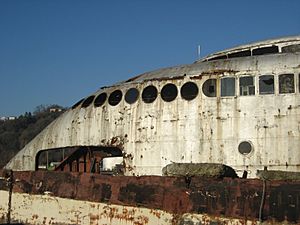
In 1967, the Kalakala stopped its ferry service and was moved to a repair facility. A year later, it was sold to a seafood company. It was then towed to Alaska to be used as a crab cannery. Later, in 1970, the Kalakala was pulled onto the shore in Kodiak and used to process shrimp.
In 1984, a man named Peter Bevis found the rusty ship while on a fishing trip. The Kalakala was still being used as a cannery. Its inside had been changed to look like a building with cement floors and walls. After many talks, the ship was floated again and towed back to Seattle in 1998. For years, the ship became a source of debate because its owners couldn't find enough money to fix it up or even keep it safely docked.
In 2004, the ship was sold to a new owner. He moved it to Neah Bay, where the Makah people allowed it to anchor. But soon after, the Makah asked the ship to leave. The Kalakala was then moved to Tacoma, Washington.
In 2008, the owner, Steve Rodrigues, said he wanted to buy more old ferries and restore them, including the Kalakala. He hoped to make them run on wind and solar power or turn them into museums. The Kalakala was supposed to be worked on in 2010, but this never happened. After six years in Tacoma, the ship started to lean. Officials worried it might cause pollution. The owner was also pressured because Washington State passed a law about removing abandoned ships. Because of these issues, the Kalakala's owner offered to sell it for just one dollar, but only if the buyer promised to fix it up.
In December 2011, the Coast Guard declared the ship a danger to boats passing by. They said its ropes and anchors were not strong enough. The Coast Guard gave the owner a deadline to fix the ship's hull and plan to move it. This deadline was not met. The owner said someone anonymous had bought the ship, but the Coast Guard rejected this claim because there was no proof of work or sale.
The Coast Guard said the ship was so fragile that it might not survive being moved. They thought it might have to be scrapped. In November 2012, Karl Anderson, who owned the land where the boat was docked, took possession of the ship. He said the owner owed him money for rent.
Taking Apart the Kalakala

On January 4, 2015, owner Karl Anderson announced that the Kalakala would be taken apart for scrap metal. On January 22, the Kalakala was towed to a dry dock in Tacoma, and the scrapping began right away. By the first week of February, the work was finished. Only a few parts, like some windows, the pilot house, and the rudder, were saved and sold as souvenirs.
Art Inspired by the Kalakala
The Kalakala inspired several art projects:
- A full music album of solo cello songs was recorded inside the ship in November 2003. It was called Songs from a Parallel Universe.
- A film about a "Ghost Dance" was made on the Kalakala, but it hasn't been released yet.
- A live concert with the Icelandic band múm, Serena Tideman, and Eyvind Kang, was held on board the Kalakala.
- The watercolor artist Robert Tandecki painted the ship in its later days.
- Artist Cory Ench painted a large mural of the Kalakala in downtown Port Angeles in 1995.
In 2002, the ship hosted the final art shows for the Design Department of Cornish College of the Arts.
A temporary pirate radio station that broadcast from the Kalakala was featured in the 2005 documentary film Pirate Radio USA.
The city of Kirkland bought some of the scrapped pieces of the Kalakala. As of 2018, they are thinking about using them in a public art project.
Images for kids


